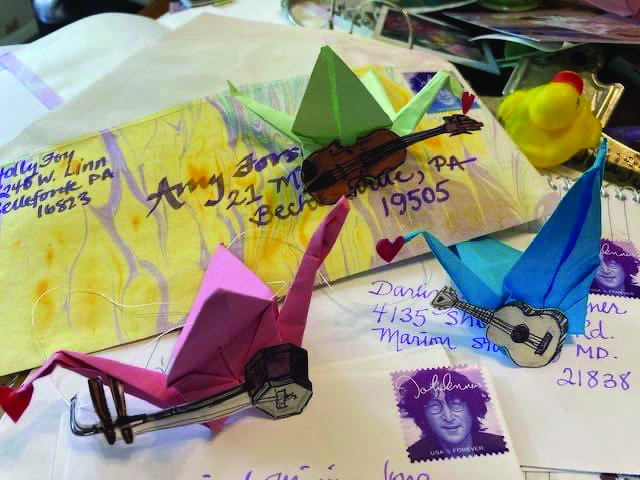
no description

no description
The Bellefonte Art Museum for Centre County is taking resourcefulness during the pandemic to a higher level, while simultaneously spreading messages of hope.
Cranes for Hope is derived from the museum’s 1,000 Cranes Project, a 2019 exhibit that was part of its annual Imagination Celebration. The cranes were an interactive programming activity; each crane was hand-folded and emulated a tradition from Japanese culture: that the folding of 1,000 cranes will allow wishes to come true.
Patricia House, executive and founding director of the Bellefonte Art Museum, says staff put their heads together to brainstorm just how the museum could stay connected to the community and serve as a source of positivity during the pandemic.
The cranes from the 2019 exhibit were just the answer they were looking for; rather than packing the exhibit away, they would send it around the world.
“The best part was really to find something we could do that was meaningful,” explains House. “We occasionally try to recycle shows by reusing the framing or something similar, but this time was different. We had this huge bag of cranes that had taken so much time and involved hundreds of people. We couldn’t throw them away; they represented too much energy and skill.”
The museum began by sharing the idea with its members and the general community through various platforms such as its website (bellefontemuseum.org) and Facebook. Those interested were allotted a time to pick up cranes and send them to friends and family with positive messages of hope.
Since the commencement of the project, the original 1,000 cranes from the exhibit have all been used, a response that still shocks the BAM community. House explains that the project is ongoing nevertheless. People who still wish to send a crane can pick up a kit with origami instructions to construct on their own and send out.
The reach of the project has surpassed expectations.
“We’ve received confirmation from at least 15 different states already,” House said in the first part of September.
The project has reached an international scope as well, with the museum receiving messages back from a boy in Ecuador and others in Ireland and South Korea.
Centre County artist Holly Foy explains that each day in August, she mailed a crane to a friend.
“The ‘crane letters’ gave me a chance to count my blessings of friends, to reminisce about fond memories of pre-COVID times, and to connect with pals that I haven’t seen in person for a while,” she says.
“My BAM cranes sit on a mantle in Pittsburgh, decorate a ship’s cabin in Newport, Rhode Island, hang from a Jeep in Georgia, while others ‘flew’ to Tennessee, Maryland, and Illinois,” Foy adds.
Another sender, Jolene Peterson, says she was told “by several of the recipients that they placed their little crane in a spot where they can see it daily, to remind them that there is always hope.”
Peterson expresses her gratitude to museum leaders for creating such an interactive project for members and people of the community during the pandemic.
Not only has the project evoked hope, but it has diverged into an opportunity that has improved the museum’s online reach and platform.
“We’ve been around for 13 years, but in the last three to four years we’ve really tried to do a lot on social media,” House explains. “We now see how much more we can do beyond our building and community. Instead of limiting interaction to events that take place within the museum, we learned they can be interactive on the internet as well.”
Looking ahead, House says she would like to keep the resourcefulness of the crane exhibit in mind when curating future displays.
Although the effects of the COVID-19 shutdown are still being felt (BAM reopened for in-person exhibits in September), museum leaders remain optimistic; many past members renewed their memberships and virtual events held by the museum over quarantine garnered the interest of hundreds.
Amid the uncertainty, House feels that ultimately the success of Cranes for Hope came from art.
“The universal need for something that was hopeful and an opportunity to feel good was what made this project so powerful,” she says.
Elizabeth Molek is a freelance writer.
Receive all the latest news and events right to your inbox.

80% of consumers turn to directories with reviews to find a local business.